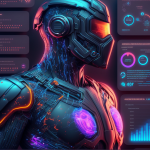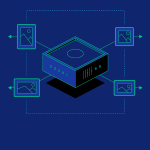From Pixel to Product: The Evolution of Digital Design Inspiration
- Post
- August 7, 2023
- Design Inspiration, UI/UX Design, Web Design
- 0 Comments
The creative process that transforms a mere pixel into a stunning product is a mesmerizing blend of artistry and innovation. In a world dominated by visual aesthetics, designers have become the modern-day artisans, sculpting digital experiences that captivate and engage. This article embarks on an exploration of the intricate journey from pixel to product, shedding light on the steps, strategies, and sources that guide this transformation.
Understanding Design Inspiration
Design inspiration is the ignition spark that fuels the entire creative process. It’s the initial burst of ideas and concepts that designers draw upon to formulate their designs. Whether it’s the fluidity of watercolors, the geometry of architecture, or the vibrancy of nature, sources of inspiration are as diverse as the designers themselves. These inspirations serve as building blocks, influencing the aesthetics, functionality, and user experience of the final product.
The Dynamic UI/UX Landscape
In the realm of digital design, UI/UX holds a pivotal role. User Interface (UI) focuses on the visual and interactive elements, while User Experience (UX) emphasizes the overall feel and usability. The best design inspiration for UI/UX often stems from a fusion of various disciplines—graphic design, psychology, human-computer interaction, and even storytelling. This interdisciplinary approach ensures that every pixel is purposeful and contributes to the user’s journey.
Unraveling the Creative Process
Conceptualization and Brainstorming
The journey begins with an idea—a mere whisper that holds the potential to evolve into a revolutionary design. Designers engage in brainstorming sessions, allowing their creativity to flow freely. This phase involves research, mood boards, and mind mapping, all aimed at shaping the concept’s core.
Sketching and Wireframing
Once the concept gains traction, it’s time to sketch and wireframe. These visual representations help translate abstract ideas into tangible structures. Wireframes provide the skeleton, outlining the layout and functionality, ensuring that the design aligns with user expectations.
Gathering Design Inspiration
As designers navigate the journey, they draw inspiration from a myriad of sources—nature, architecture, art, technology, and even emotions. The fusion of these influences ignites the spark that elevates the design beyond the ordinary.
Color Palette and Typography
Colors and typography form the language of design. Designers meticulously choose a color palette that evokes emotions and aligns with the brand’s identity. Typography, on the other hand, complements the visuals, ensuring readability and aesthetic harmony.
Prototyping and Testing
Prototyping transforms the design from static to interactive. Designers create prototypes that simulate user interactions, allowing them to fine-tune the UX. User testing provides invaluable feedback, enabling designers to identify pain points and areas of improvement.
Refinement and Iteration
The path from pixel to product is rarely linear. Designers iterate, refine, and iterate again. This iterative process hones the design, ironing out imperfections and enhancing the user experience.
The Role of Technology
In the digital age, technology is an enabler that empowers designers to bring their visions to life. Tools like Adobe Creative Suite, Sketch, Figma, and InVision streamline the design process, offering a canvas where creativity knows no bounds. Additionally, AI-powered tools are emerging, assisting designers with tasks like generating design variations, optimizing layouts, and even predicting user preferences.
Final Words
The journey from pixel to product is a saga of creativity, innovation, and tireless dedication. Designers embark on a transformative voyage, fueled by design inspiration ideas that shape every pixel, every interaction, and every experience. In the dynamic world of UI/UX design, the fusion of art and technology results in products that resonate with users and stand the test of time.
Commonly Asked Questions
Q1: How do designers find design inspiration?
A: Designers draw inspiration from various sources, including nature, architecture, art, and technology. It’s a process of blending diverse influences to create unique and compelling designs.
Q2: What’s the significance of UI/UX design?
A: UI/UX design focuses on crafting user-centric digital experiences. It ensures that products are visually appealing, functional, and intuitive, enhancing user satisfaction.
Q3: How does prototyping contribute to the design process?
A: Prototyping allows designers to create interactive mockups of their designs, simulating user interactions. This helps identify usability issues and refine the user experience.
Q4: How does technology impact modern design?
A: Technology provides designers with powerful tools to streamline the design process and bring their ideas to life. AI-powered tools are also emerging, augmenting creativity and efficiency.
Q5: What role does iteration play in design?
A: Iteration involves refining and improving the design through multiple cycles. It’s a crucial process that ensures the final product meets user needs and expectations.




